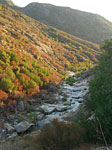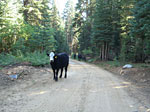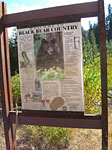Golden Trout Wilderness, Southern Sierra, Kern County, California
Overnight hike to a string of mountain lakes
| Maggie Lakes, Frog Lake, Twin Lakes
via Summit trail Golden Trout Wilderness, Southern Sierra, Kern County, California Overnight hike to a string of mountain lakes |
| Maggie Lakes are three
jewels in the South Sierra's Golden Trout Wilderness, about a 9 mile hike
from Summit trailhead. Although they aren't named as such, I call them
lower, middle and upper Maggie Lake. Frog Lake and the Twin Lakes are
one and two miles north, respectively. Who is Maggie? I don't know, but
get ready for enormous trees, amazing rock formations, a string of
pristine wilderness lakes and a strenuous but rewarding workout
exploring a giant wilderness area that relatively few know about. This is an overnight hike of about 25 mi. total, out and back again. It took me a little more than 5 hours, including two 10 minute breaks, to get to the first Maggie Lake. From the trail map, one would expect grand views of 10,042' Maggie mountain much of the hike, as the trail winds up and around her flanks, but there are only a few hard-won glimpses of her elusive summit through the thick forest. The sign at the trailhead says 7 miles to Maggie Lakes, but that must be as the crow flies. I'm going to call it more like 8 1/2 to 9 miles with all the switchbacks. It's a strenous hike - there are some very steep segments that will have you breathing hard. After a long drive up from LA after work, I arrived at the Summit trailhead parking lot past 11:00 Friday night, set up my tent and went straight to sleep. Hunting season had begun and I shared the dirt and gravel parking area with several tents and trucks with hunters and a giant horse trailer too. |
Next morning, after a
quick breakfast, I tied a bright color on my pack and was on the trail
by 7:30, trying to put as much distance as possible between myself and
a group of 4 loud dayhikers who rolled up in a cloud of dust just as I
was breaking camp. Spoke with a young deer hunter one mile in who said he'd already seen 3 bears. He'd yelled out "Bear!" to me from the trail high above so that I could see one, but he was in camouflage and I couldn't see him until I got a lot closer, so I missed it. Because hunters are supposed to haul out their kills, they generally don't trek into the wilderness very far from their trucks. So the farther in you go, the less chance you have of meeting up with hunters, except those on horseback. I'm not inclined to kill a deer or bear for sport myself, but I think it may be the only way they'll learn a healthy fear of humans. With the klak klak from my trekking poles announcing me, I don't have too many animal encounters, but I did get studied by several deer with their fawns on this hike. I ran across only that one group of dayhikers and about 10 horsemen on the trail the whole two days. |
| Summit Trail is in good
shape and easy to follow for the most part but many of the trail intersection
signs are either down or damaged as of this writing, so bring a map
and a compass or GPS. The path is generally good condition hard pack
dirt. There is moderate use by stock (horse & mule), but not enough
to damage it. The trailhead is at the far end of the parking area. I found out from the Springville ranger station that there hadn't been a maintenance crew on this trail in at least two years, so I didn't know what to expect. But I'd read there had been lightning fire closures in this area since then so that meant fire crews may have been out clearing trees that had toppled across the path. There were two or three short detours around fallen trees on this visit, including one giant sequoia near Griswold Meadows that a new trail was created to bypass. (Stay left). From the trailhead, the path winds around and down the mountain right away, almost 1000 ft. to a gurgling cascade, then climbs right back up the adjacent mountain 1000 ft. and more. As you start down, that mountain there on your right directly across the valley is where you'll be going back up, up, up to the same height. Then it levels off for a mile before another very steep segment of switchbacks that put you high on a ridge, with expansive views east and west. From here, the trail is more level for a few miles through thick forest to a series of alpine meadows. When you near Maggie mountain, once again the trail climbs steeply, circling the perimeter. (You don't see the summit from the trail). After rounding a high point at the north flank of Maggie mountain, you'll first see the valley ahead and the mountains to the northwest that hold Maggie Lakes. |
Middle Maggie is just above lower. A boulder slope separates two. There is a semblance of a trail around the far (west) side of the lake. There's really no trail to speak of to the upper lake, just head southwest up the hill from Lower Maggie and you'll see it in ten minutes. North of Maggie Lakes, Summit trail to Frog Lake and Twin Lakes climbs 500 ft. up through a giant boulder field and is easy to lose. This is where I was thankful to see horse manure to follow. You'll need to be extra vigilant, keep your map and compass handy and look for cairn markers to stay on the trail here. After Frog Lake, the trail is easier to follow to Twin Lakes. |
| STATISTICS |
| Maggie Lakes, Frog Lake, Twin Lakes
via Summit trail Height: 9500-10,000 ft. Elevation gain: Approx. 2000 - 2200 ft. one way Distance: 12-13 miles one way Duration: 8-9 hours one way Difficulty: Strenuous Water availability: Several streams flowing. Lakes are full year round. |
| From Los Angeles, take
I-5 to Hwy. 99 to Bakersfield, about 3 hours. The fastest route is to
stay north on 99, a divided highway, then go east on Hwy. 190 to Porterville
and Springville. You could also take Hwy. 65 north out of Bakersfield,
a more direct but slower route to Porterville. From the highway
190 bridge over the Tule River on the east side of Springville, it's
24.4 miles on Hwy 190 east up the mountain to North Road (Forest Service
road 21S50). T/L (north) on to North Road. There was no sign post for
North Rd. on my trip, but there is an "End Hwy. 190" sign. (Highway
190 then becomes "Mountain 99"/Sierra Highway down to Kernville.) From
here, it's 10.5 miles to Summit trailhead. North Road is long and twisty with numerous turnoffs and sub-roads, and provides access to many camps and trailheads - among them Lewis Camp, Clicks Creek, Jordan Peak and Summit trailheads. The first few miles are pavement, then a combination of dirt and pavement. The last few miles are dirt and rock and the road narrows to little more than one lane, so keep an eye out for wide spots in case you have to back up some distance to let someone by. After a few miles in, you may encounter herds of black cows in the road at any time. Much of the length is sided with tall trees so there is little orienting yourself without a map and signs or a GPS. |
The entire length of
North Road to Summit trailhead is accessible via passenger car in dry
weather, but the last few miles are covered with large jagged stones,
which make for slow going. The U.S. Forest Service requires you to acquire and carry a free Wilderness Permit for overnight visits to the Golden Trout Wilderness. (In some areas, visitor and trailhead quotas are in effect "to protect the wilderness from visitor impact and over use.") Permits are valid for specified dates only and not required for day use. If you want a campfire, a free campfire permit, verifying your knowledge of and adherence to fire guidelines, must also be carried. Campfire permits don't expire and can be reused.
| ||
|
|||
| Getting there | |||||
 Lake Success, a reservoir east of Springville, fed by the Tule River. |
|||||
 East of Springville, the Tule has cut a deep and impressive gorge. |
 Beware of free-range cattle on North Rd., which skirts numerous fence-free meadows and pastures. A series of cattle guard pits keep them from wandering off. |
 Bear sign at Summit trailhead. Here is big version, in case you want to read it. |
|||